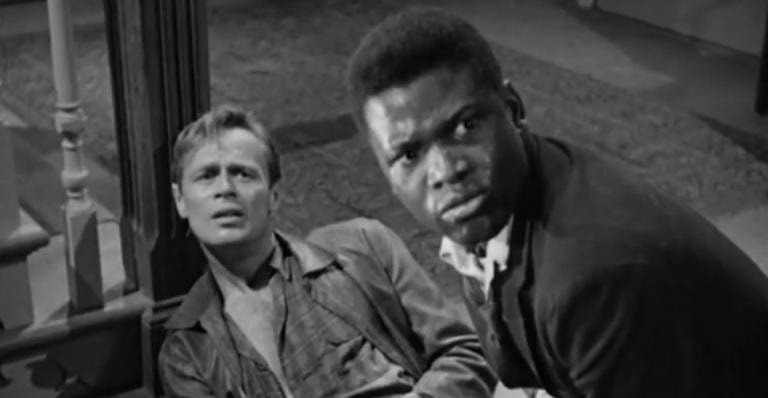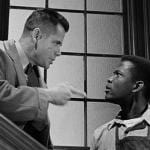Like many other people, I’ve been watching a lot of stuff online since the pandemic began one year ago. For me, this has meant watching a lot of films grouped around different actors or directors — and one of my very first projects consisted of an almost-complete marathon of the films of Sidney Poitier, the first black man to win the Oscar for best actor and also the first black man to direct a $100-million-grossing movie.
At the time, I wrote short notes about all of these films on Facebook, noting how the films reflected some very pivotal decades in the history of race relations, both in the United States and around the world. (Poitier grew up in the Bahamas; his first film took place in the United States; his second film took place in South Africa; and in one of his most famous films, To Sir with Love, he played a South American working in Europe.)
I watched most of these films in April of last year, at a time when many of them were about to leave the Criterion Channel. Now, for Black History Month, I figured it might be a good idea to dust off my notes and post them to this blog. These notes are pretty informal, but they do cover nearly half a century of film, from Poitier’s first credited role in 1950 to his final big-screen appearance in 1997. (He appeared in a few more TV productions after that, but I could not find most of those films online.)
I will be posting these notes every weekday in February. Here is the first batch:
–
Sidney Poitier marathon part 1 (1950):
The Criterion Channel is going to be losing a whole bunch of Sidney Poitier movies at the end of the month, so I figured I might try to see as many as I can, in chronological order. But they don’t have his first film, No Way Out (1950) — so I tracked it down on YouTube and watched it today.
It’s an interesting film. Poitier gets fourth billing or something like that, but he’s actually the main character: a young doctor at the beginning of his career (Poitier was 23 when the film came out) who is accused of murdering a white patient by the patient’s super-racist brother. Absolutely nobody at the hospital believes the racist — they all accept Poitier’s claim that the patient died from a pre-existing condition — but Poitier wonders if he might have made the wrong diagnosis because he was reacting to the brother’s racism subconsciously, and he wants to perform an autopsy to prove to everyone, including himself, that he made the right call. But Poitier can’t perform an autopsy without the family’s permission, and in this case “family” means the patient’s racist brother, who rejects the autopsy while promising to whip up the equivalent of a lynch mob.
(I can’t recall if the film ever specifies which city it is set in, but I assume it couldn’t have been in the South if a black doctor is so easily accepted at a non-black hospital. And that’s one of the interesting things about the film: how there is no racism at all among the hospital staff, which seems a bit idealized — the doctors care only about science and whether a doctor can get the job done! — although one of the administrators does express concern about the effects that a racially-charged controversy might have on his fundraising efforts. And there’s a black elevator operator who assumes that Poitier has been subjected to more racism than he lets on, and who whips up a mob of his own — against Poitier’s protests — when he hears what the patient’s racist brother is planning.)
As always, I’m curious to know what sort of reception this film got back in the day. In a video that accompanies the Criterion series, a film critic compares Poitier’s significance as a movie star to that of Jackie Robinson as a baseball star; Robinson became the first black baseball player to play for a Major League Baseball team in 1947, just three years before this movie came out. (And then Robinson played himself in The Jackie Robinson Story, which came out in 1950, the same year as No Way Out.) No Way Out was also produced by 20th Century Fox, which had tackled anti-Semitism in Gentleman’s Agreement, which also came out in 1947; so a film that addressed this other form of racism would seem to have been very much on-brand for that studio at that time.
I’m not very familiar with Poitier’s ouevre, but I have seen the three classics that he made in 1967 — In the Heat of the Night, Guess Who’s Coming to Dinner and To Sir with Love (I watched that last film many times when I was a kid; it was one of the first movies my dad taped on our big bulky VCR in the late 1970s) — and Poitier has always seemed so authoritative to me that it’s kind of bracing to see how much verbal abuse he has to endure in this 1950 film. He’s still very much in turn-the-other-cheek mode; neither he nor the wider culture have quite gotten to the point yet where he can slap a man back (as he very famously does in In the Heat of the Night). But seeing how he gets from Point A to Point B is one of the reasons I’m interested in going through his filmography. The question now is how far I’ll get over the next not-quite-four weeks…
–
Sidney Poitier marathon part 2 (1951-1954):
Following his debut in No Way Out, where he basically played the central character even if he only got fourth billing, Poitier went on to play supporting roles in a handful of films that offer an interesting window onto mid-20th-century history.
Cry, the Beloved Country (1951) is one of the few Poitier films that I had already seen, and I owe my familiarity with the film to two things: One, my father — who grew up in Zambia and was deported from South Africa after taking part in some anti-apartheid protests as a university student — loved the film and taped it off TV when I was a kid; and two, I watched this film (and read the 1948 novel on which it is based) as research before writing my review of the remake in 1995.
Cry is the first film in the Criterion Channel’s Poitier collection, but Poitier himself doesn’t make much of an impression in it. The film’s central character is an old black priest from the country who travels to the big city, Johannesburg, to find his sister and his son — and who discovers, among other things, that his sister has turned to prostitution and his son has murdered a white racial-justice activist who happened to be the son of a rich white man from their village. (The novel was published several months before apartheid became the law of the land, and the movie was made just a few years later, so apartheid is very much a part of the film’s subtext even if it is not part of the text, per se.) Poitier plays a priest from the city who helps the country priest find his way around, and there’s not much more to his role than that. (When the script calls for a black priest to protest the division that exists even between white and black priests, it is another character, not Poitier’s, who makes this point.)
Poitier has an even smaller role in Red Ball Express (1952), which is all about the truck convoys that brought supplies to the Allied troops in France after D-Day (which was only eight years before the movie was made!). Wikipedia says the real-life Red Ball Express was about 75% African-American, but the convoy we see in this film is a lot whiter than that. Still, there are three black characters of note, and it’s particularly interesting — given Poitier’s reputation later on for playing perfect, flawless characters who made white audiences feel safe — that Poitier plays the one black character who has a significant chip on his shoulder: he gets into fights with a white soldier who jokes about “minstrel shows”, and he asks to be transferred from his unit because he assumes that the main reason his lieutenant doesn’t want to chat with him on their long drives through France is because the lieutenant is racist. (“He outranks us the way we’ve been outranked all our lives,” says Poitier to the other black troops at one point.) It’s the other black soldiers who get along well with their white comrades, and who lead them in song as they load and unload the trucks, etc.
And then there is Go Man Go (1954), a film about the origins of the Harlem Globetrotters, which focuses primarily on Jewish team manager Abe Saperstein but also includes Poitier as basketball player Inman Jackson, who, according to one online encyclopedia I found, was “second only to Abe Saperstein in creating the phenomenon known as the Harlem Globetrotters.” Poitier’s Jackson isn’t the player we see walking side-by-side with Saperstein at the very end of the film, though! (Inman’s wife Irma is played by Ruby Dee, who had previously appeared with Poitier in No Way Out and had also played Jackie Robinson’s wife in The Jackie Robinson Story, both in 1950.)
Go Man Go might be the first Poitier film in which race is not a significant theme, or at any rate is not addressed directly in the dialogue. The film is also noteworthy for being directed by legendary Chinese-American cinematographer James Wong Howe; indeed, it may be the only non-documentary feature on which Wong Howe had the sole directorial credit. And the fact that he did direct documentaries is reflected, I think, in the basketball-game scenes, which look almost like newsreel footage (and for all I know might be newsreel footage; I do know that some of the Globetrotters played themselves in this film).
Anyway. Red Ball Express and Go Man Go are not on the Criterion Channel, but they sounded interesting enough that I looked them up online. I can’t promise I’ll be this exhaustive with the rest of Poitier’s filmography, though! (Poitier also appeared in a few TV shows during this period, but I certainly have no intention of tracking those down.)
–
The image at the top of this post shows Richard Widmark and Sidney Poitier in No Way Out.














